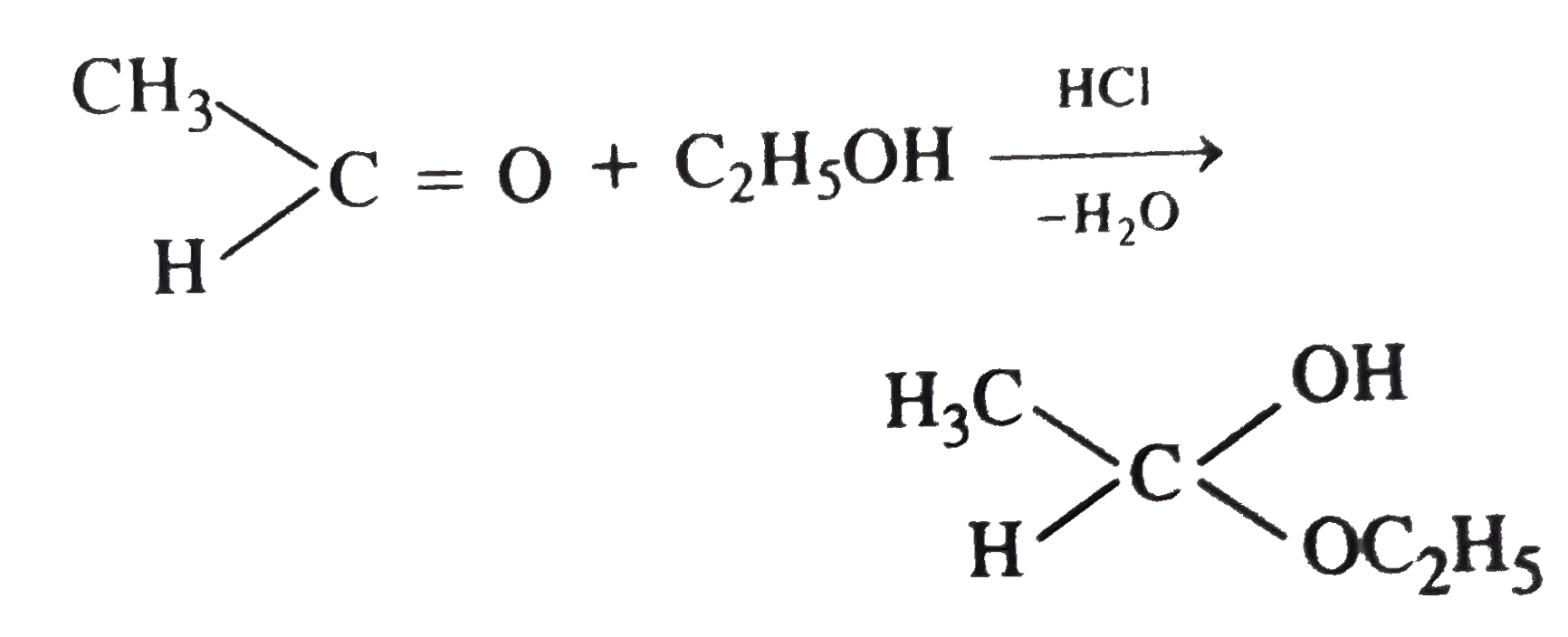Acetal is produced by reacting alcohol in the presence of dry HCl with
Acetaldehyde
Ketone
Ether
Carboxylic acid.
The correct Answer is:A
Similar Questions
Aldehydes react with one equivalent of monohydric alcohol in the presence of dry hydrogen chloride to yield alkoxyalcohol intermediate , known as hemiacetals, which further react with one more molecule of alcohol to give a gem - dialkoxy compound known as acetal. Ketones react with ethtlene glycol under similar conditions to form cyclic products known as ethylene glycol ketals. Dry hydrogen chloride protonates the oxygen of the carbonyl compounds and therefore, increases the electrophilicity of the carbonyl carbon facilitating the nucleophilic attack of ethylene glycol. Acetals and ketals are hydrolysed with aqueous mineral acids to yield corresponding aldehydes and ketones respectively.
Whaat is teh role of dry HCl in the formation of hemiacetal by aldehydes using a primay alcohol ?
View SolutionWrite the name of the product when ketones react with 1,2-diol in presence of dry HCl .
View Solution
Knowledge Check
Acetal is produced by reacting an alcohol in the presence of dry HCl with
AacetaldehydeBketoneCetherDcarboxylic acidAcetal is produced by reacting alcohol in the presence of dry HCl with
AAcetaldehydeBKetoneCEtherDCarboxylic acidAcetaldehyde and ethyl alcohol reacts in presence of dry HCI. Gas The products obtiained is :
ACH3CH2CH2OHBCH3−CH(OH)−CH3CCH3−CH(OH)−C2H5DCH3CH(OC2H5)2
Acetic acid reacts with ethyl alcohol in the presence of concentrated sulphuric acid producing a sweet smelling compound. For the reaction :
(i) name the main product (ii) write chemical equation.
View SolutionAldehydes react with one equivalent of monohydric alcohol in the presence of dry hydrogen chloride to yield alkoxyalcohol intermediate , known as hemiacetals, which further react with one more molecule of alcohol to give a gem - dialkoxy compound known as acetal. Ketones react with ethtlene glycol under similar conditions to form cyclic products known as ethylene glycol ketals. Dry hydrogen chloride protonates the oxygen of the carbonyl compounds and therefore, increases the electrophilicity of the carbonyl carbon facilitating the nucleophilic attack of ethylene glycol. Acetals and ketals are hydrolysed with aqueous mineral acids to yield corresponding aldehydes and ketones respectively.
How can we recover the aldehydes and ketones from acetal and ketal ?
View SolutionAldehydes react with one equivalent of monohydric alcohol in the presence of dry hydrogen chloride to yield alkoxyalcohol intermediate , known as hemiacetals, which further react with one more molecule of alcohol to give a gem - dialkoxy compound known as acetal. Ketones react with ethtlene glycol under similar conditions to form cyclic products known as ethylene glycol ketals. Dry hydrogen chloride protonates the oxygen of the carbonyl compounds and therefore, increases the electrophilicity of the carbonyl carbon facilitating the nucleophilic attack of ethylene glycol. Acetals and ketals are hydrolysed with aqueous mineral acids to yield corresponding aldehydes and ketones respectively.
Write the reaction showing hydrolysis of ketal to obtain ketone
View SolutionAldehydes react with one equivalent of monohydric alcohol in the presence of dry hydrogen chloride to yield alkoxyalcohol intermediate , known as hemiacetals, which further react with one more molecule of alcohol to give a gem - dialkoxy compound known as acetal. Ketones react with ethtlene glycol under similar conditions to form cyclic products known as ethylene glycol ketals. Dry hydrogen chloride protonates the oxygen of the carbonyl compounds and therefore, increases the electrophilicity of the carbonyl carbon facilitating the nucleophilic attack of ethylene glycol. Acetals and ketals are hydrolysed with aqueous mineral acids to yield corresponding aldehydes and ketones respectively.
Give the reactions of fomation of alkoxyalcohol.
View SolutionThree molecules of acetone in the presence of dry HCl form :
View Solution


